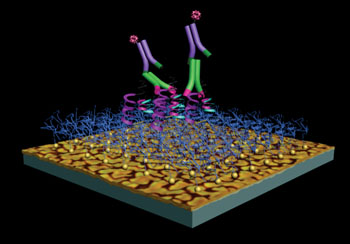Microchip Invented for Faster, Simpler Type-1 Diabetes Diagnosis, Risk Assessment, and Biomarker Discovery
By LabMedica International staff writers
Posted on 23 Jul 2014
Researchers have succeeded in developing a low-cost, portable, nanotech microchip-based test for diagnosing type-1 diabetes that would speed diagnosis and screening, and enable new approaches to studying how the disease develops.Posted on 23 Jul 2014
The type-1 diabetes (T1D) microchip test was invented by a Stanford University (Stanford, CA, USA) team led by Stanford University School of Medicine's Brian Feldman, MD, PhD, assistant professor of pediatric endocrinology, the Bechtel Endowed Faculty Scholar in Pediatric Translational Medicine, and pediatric endocrinologist at Lucile Packard Children’s Hospital Stanford. It distinguishes between the two main forms of diabetes mellitus – T1D, being an autoimmune disease, has auto-antibodies not present with type-2 diabetes (T2D). Until now, making the distinction has required a slow, expensive test available only in sophisticated health-care settings. The new handheld, inexpensive test can be performed outside hospital settings and could improve patient care worldwide; including satisfying a global need in many parts of the world where the old test is prohibitively expensive and difficult to perform. The researchers are seeking US Food and Drug Administration (FDA) approval of the device.

Image: The inexpensive type-1 diabetes microchip test relies on fluorescence-based antibody detection. The innovation is that the glass plates forming the base of each microchip are coated with an array of nanoparticle-sized islands of gold, which intensify the fluorescent signal, enabling reliable antibody detection (Photo courtesy of Prof. Brian Feldman, Stanford University, and Nature Medicine).
The old, slow test detects the auto-antibodies using radioactive materials, takes several days, can only be performed by highly-trained lab staff, and costs several hundred dollars per patient. In contrast, the new, relatively low-cost microchip method uses no radioactivity, produces results in minutes, and requires minimal training to perform. And each chip, expected to cost about USD 20 to produce, can be used for upward of 15 tests. The microchip also uses a much smaller volume of blood than the older test: instead of a lab-based blood draw it can be done with blood from a finger prick.
“With the new test, not only do we anticipate being able to diagnose diabetes more efficiently and more broadly, we will also understand diabetes better — both the natural history and how new therapies impact the body,” said Prof. Feldman. Better testing is also needed as recent changes in who gets T1D vs. T2D have made it risky to categorize patients based on their age, ethnicity, or weight, as was common in the past due to the sharp distinctions that no longer exist. A cheap handheld test in the doctor’s office would help prevent adult patients from undergoing damaging incorrect treatment due to having been misdiagnosed with T2D. Also, there is growing evidence that early, aggressive new therapies of T1D improves patients’ long-term prognoses, possibly via halting the autoimmune attack on the pancreas and preserving some of the body’s ability to make insulin.
In addition to new diabetics, people who are at risk of developing T1D, such patients’ close relatives, may also benefit as the test will allow doctors to quickly and cheaply track their auto-antibody levels before onset of symptoms. Furthermore, because of its low cost, the test may allow the first broad screening for T1D auto-antibodies to identify those at risk in the population at large. The test would also facilitate testing for volunteers in programs such as "TrialNet," the nationwide USA study that monitors risk of relatives of T1D patients.
“The auto-antibodies truly are a crystal ball,” said Prof. Feldman, “Even if you don’t have diabetes yet, if you have one auto-antibody linked to diabetes in your blood, you are at significant risk; with multiple auto-antibodies, it’s more than 90% risk.” “There is great potential to capture people before they develop the disease,” added Prof. Feldman, “But the old test was prohibitive for that type of thinking because it was so costly and time-consuming.”
The microchip, a plasmonic chip, relies on fluorescence-based antibody detection. The team’s innovation is that the glass plates forming the base of each microchip are coated with an array of nanoparticle-sized islands of gold, which intensify the fluorescent signal, enabling reliable antibody detection. The test was validated using blood samples from people newly diagnosed with diabetes and from people without diabetes. Blood samples from both groups were tested with both the old test and the microchip-based test.
The study, by Zhang B, Kumar RB, Honjie D, and Feldman BJ, was described in the journal Nature Medicine, July 13, 2014 (online ahead of print).
Related Links:
Stanford University
Stanford University School of Medicine














